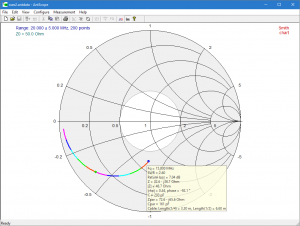Measure MLL using the half ReturnLoss method
Again in the theme of measuring something known, let us determine the matched line loss (or normally quoted attenuation) of our cable at 3.5MHz.
To make the measurement, just connect the two test line sections used in the earlier articles in this series in cascade with a joiner, and one end on the instrument, other end open circuit, and measure ReturnLoss.
Most analyser manuals and lots of helpful articles in journals and handbooks will tell you that MLL=RL/(2*length) where RL is the ReturnLoss of an open circuit or short circuit line section (the only requirement is that the ρ=1 at the line end).
Wow, that is so low, and using the traditional formula:
MLL=0.02/(2*4)=0.0025dB/m.
Of course we are measuring way low in the instrument’s capability and there is some considerable uncertainty… but when we consult a good transmission line loss calculator, we expect around 0.029dB/m… that is 12 times what we measured. Continue reading Exploiting your antenna analyser #4




